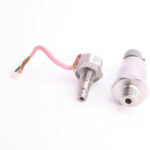For any given pressure media, the actual response time of a sensor is normally given in seconds (fastest time) or frequency (Hertz), which is a unit describing the number of cycles or “pulses” per second.
F (Hz) = cycles/second or cycles = second/Hz
eg 100Hz = 0.01s = 10ms
The overall frequency response is determined by:
- Mechanical natural frequency
- Acoustic natural frequency of the port assembly
- Frequency response of the internal amplifier
- Volumetric displacement of the sensing element
Mechanical natural frequency
The mechanical natural frequency is determined by thickness and construction of the diaphragm: ie the thinner the diaphragm (low pressure ranges) the greater the deflection, and the faster the response time. Generally, a flush diaphragm sensor has the fastest response time when mounted flush, compared with ready-ported sensors that are limited because of the port restriction.
Acoustic natural frequency
For sensors that use fitted pressure ports the limiting factor can often be the acoustic/media response restricting the flow of media (fluid) to the diaphragm. In its simplest form, a pressure port assembly can be considered as a Helmholtz resonator. The response time, of course, depends on the media being measured, be it air, water, oil etc.
Internal amplifier frequency
In order to ensure that the onboard amplifiers in a sensor give a smooth signal output and to ensure correct operation, lowpass filters (capacitors) are fitted, and these slow down the response time.
Volumetric displacement of the sensing element
The volumetric displacement of the sensing element is the change of volume the diaphragm detects from zero to full scale. However, due to the difficulty in accurately measuring this phenomenon, volumetric displacement is only a consideration in very specialised situations.
In general, the response time of a pressure sensor is much faster than that of a pressure gauge. Indeed, in some cases pressure sensors can be too fast to be followed by standard electronics, such as amplified indicators etc. In such situations, it is possible for a sensor to be mechanically overloaded, which would never be indicated by pressure gauges or associated electronics.
Note that since the introduction of CE marking the majority of sensors now come with integral filters. This makes it easier to pass the regulations but it does give the sensor a slower response time.
Read more: Index to all of our Technical Notes on Pressure
Have a pressure application you want to discuss? Let us call you…
Why Us?
- Suppliers of top quality strain gauge sensors and transducers to every corner of industry – UK and worldwide
- Over 100 years of expert transducer knowledge
- Our high quality products all come with a 3 year warranty





